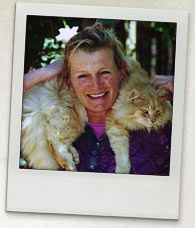Alison Lester masterclass
Teaching notes



How to use the Alison Lester masterclass
Alison Lester’s interview and masterclass are components of ‘Alison Lester talks’, which is part of the larger resource, Writers talk. Both components aim to stimulate students to read, write and respond to literature.
Alison Lester’s masterclass provides students with insight into the working methods of a popular and successful writer/illustrator. Students have the opportunity to participate in a virtual masterclass with the award-winning Lester and to write and illustrate their own books.
‘Alison Lester talks’, along with Lester’s books, can be used to support students working towards achieving outcomes in the Stages 1, 2 and 3 English and Creative Arts syllabuses. The syllabuses can be found at:
English
Stage 1
Through the masterclass, learning activities and study of Lester’s books, students have the opportunity to:
- identify the purpose of illustrations in texts and how they contribute to understanding and enjoyment of texts (RS1.7)
- write and illustrate simple literary texts write for a chosen purpose and audience. (WS1.9, WS1.13)
Stage 2
Through the masterclass, learning activities and study of Lester’s books, students have the opportunity to:
- talk about how writers achieve their purpose using text and illustrations (RS2.7)
- use other texts as models for producing texts for a chosen purpose and audience and to group and organises ideas and text (WS2.9)
- develop an understanding of the structure of texts (RS2.8)
Stage 3
Through the masterclass, learning activities and study of Lester’s books, students have the opportunity to:
- recognise and discuss techniques used by writers to achieve their purpose (RS3.5, TS3.1)
- express and justify opinions on the role of illustrations in books (RS3.7)
- analyse ways in which writers structure illustrations and text to engage their audience (RS3.8)
- write and illustrate well-formed literary texts for a chosen purpose and audience using planning elements such as discussion, note taking, list making and illustration. (WS3.9, WS3.13)
Creative Arts
Stage 1
Through the masterclass and study of Lester’s books, students have the opportunity to:
- investigate and make visual representations of both the imagined and real (VAS1.1)
- talk and write about the illustrations that both Lester and other young writers/illustrators present in their picture books (VAS1.3)
Stage 2
Through the masterclass and study of Lester’s books, students have the opportunity to:
- consider their intentions for making illustrations for their own books (VAS2.1)
- discuss Lester’s reason for making artworks and her role as author/illustrator (VAS2.3)
Stage 3
Through the masterclass and study of Lester’s books, students have the opportunity to:
- explore subject matter in relation to their own texts (VAS3.1)
- identify the audience for their own texts and develop illustrations for these with the audience in mind (VAS3.2)
- discuss artworks in the texts and realise that audience members have different opinions about artworks (VAS3.3)
Quality teaching
Alison Lester’s masterclass, along with study of texts written by the author, can be used to address the elements of Quality teaching in NSW public schools.
The masterclass, related classroom discussion and learning activities enable students to:
- explore the features of stories and concepts developed by current writers whose work is acknowledged for its significance (Higher-order thinking)
- experience specialist expertise through the masterclass model and develop an understanding of the role of the author and of the concepts and ideas that inform and motivate the writing of stories (Deep knowledge)
- learn to use the metalanguage of literary criticism (Metalanguage)
- learn that knowledge is socially constructed with multiple layers and personal interpretations (Problematic knowledge)
- build upon prior knowledge, such as knowledge of book structure, through study of their own texts and those of others (Background knowledge)
- make meaningful connections between subject areas and address outcomes across key learning areas (Knowledge integration)
- recognise and explore connections between their own lives and both the subject matter and creative processes employed by authors. This might include seeking out other books by the featured author, or books on similar topics, and sharing their own writing with audiences both within and beyond the school arena (Connectedness)
- use narratives, such as the masterclass, as a way of developing creative processes (Narrative)